
Tuatara
Alan and Jean sharing our cruising news with friends, family.
20 July 2015 | Rabi Island Fiji
29 June 2015 | Suva Fiji
18 December 2013 | Auckland
05 December 2013 | Auckland
27 October 2013 | Vavau Tonga
12 September 2013 | Samoa
24 July 2013 | Moorea, Tahiti
19 July 2013 | Papeete
19 June 2013 | Nuka Hiva
02 June 2013 | Pacific Ocean
29 May 2013 | Pacific Ocean
24 May 2013 | Eastern Pacific Ocean
19 May 2013 | Western Pacific Ocean
16 May 2013 | Western Pacific Ocean
13 May 2013 | Isla Isabella
06 May 2013 | Isla Isabella
08 April 2013 | Shelter Bay marina, Colon.
28 March 2013 | Belize
27 March 2013 | Belize
03 March 2013 | Panamarina, Panama
Cuba part 2
28 March 2013 | Belize
Jean
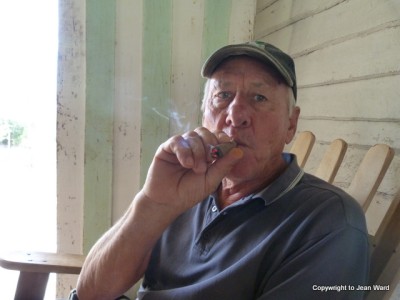
Cuba Part 2
28 March 2013
Trinidad on the south coast is the third oldest city in Cuba. Now a World Heritage site but in pre Castro times this lovely Colonial town was already recognised as a National Monument. Havana and Trinidad are the two must sees for tourists, after those there are many other interesting places to visit in Cuba. We only had 10 days so decided on just 4 places and spent a few days in each. Cuba is a big island and travelling between places can take time. We had three nights in Trinidad we took our time wandering the cobble stone streets, admiring the pastel coloured houses and enjoying music in the cool of the evening. The south coast was a lot hotter than Havana, we were glad of the little courtyard off our room for afternoon siestas.
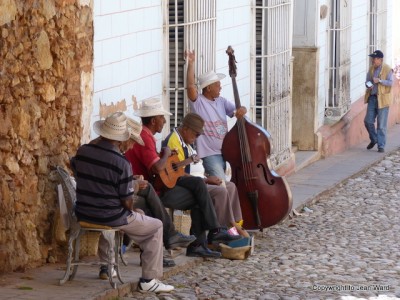
The elegant Colonial buildings around the Plaza Major are mainly museums and art galleries but in the 18th Century they were the homes of Sugar plantation owners. The surrounding country side was the main producer of sugar in Cuba although now tourism produces more income in the area with the sugar industry in decline. The pretty plaza is overlooked by the huge Cathedral, Iglesia Paroquial de la Santisima Trinidad with its plain but impressive interior. We went into the Architectural museum, a large restored house dating from 1735. The lady guiding us only had Spanish and we said,"no we don't need a guide, we only have a little espanol ". But she insisted and chatted a way in Spanish while we read the English labels. When we got around the corner out of sight of the main desk she produced a bag of embroidered cloths. We got the message, did we want to buy. Well as it happened I had already looked at some in the street. The beautiful cloths seemed a speciality of the area, I succumbed to one of hers it was lovely and better price than in the shops outside. Deal done, she indicated I should put it in my bag, out of sight, she stashed her bag and we continued on as if nothing happened!! One way for her to earn a little more money to go with the tips she gets from her guiding.
In the streets on the edge of the Plaza is a market for local people to sell their craft, jewellery, paintings, embroidery and some other ingenious items made from recycled cans. Cans turned into cameras that pop out a face, the tabs from cans combined with crochet to make little clutch bags and much more. While discussing these things 3 other NZers heard Alans, "bloody brilliant" and accused us of being Aussies!!! We soon corrected them about that, we couldn't be too rude as its always great to meet our fellow countryfolk and there doesn't seem to be many NZers in this part of the world. We had a nice chat over lunch, saying we may see them again in Trinidad, which we didn't but we did see them days and many miles later in Guatemala.
Being on the coast, Trinidad has some nice beaches so we decided to take the tourist circuit bus out to Playa Ancon and also visit the small marina. We knew that Patrick and Amanda had moved on to Cienfuegos but we would take a look anyway. The marina is only very small and the channel in is quite shallow so not many boats can get in. We found we did know someone there...well sort of, the yacht Tana Vika, we had never met but they come up on the Magellan Net from time to time.
"Come aboard for a cup of tea".
We spent our time between buses chatting, we never did get to the beach. Tony and Angela were off to Vinales by bus the next morning. That morning we had just booked a ticket to Vinales on the same bus. So we ended up spending the next few days in Vinales with them. It was nice to have some travelling companions for a while, Tony and Alan could talk boats for hours while Angela and I enjoyed the scenery.
Vinales is the tobacco growing area of Cuba in the Pinar del Rio province west of Havana. Valle de Vinales is full of green tobacco fields surrounding limestone hills called mogotes. The bus ride from Trinidad was a long one, through brown countryside and sugarcane fields. This is the dry season, the country side is very dry, that is until we climbed the last hill and looked down into the pretty green valley. Tobacco and maize fields dotted with small farm houses and thatched tobacco drying sheds. The bus driver had not said a word for about 9 hours but the proud way he said.
"Valle de Vinales"
as we crested the hill I could tell this was his home.
The town of Vinales is quite small every other house seems to be a Casa Particular and as the bus pulled up there was a bit of a scrum of Casa owners vying for customers. Carlos in Trinidad had booked us into Maria Luisa, "famillia", so we quickly spotted our host holding up our name and away we went, leaving the melee behind. We got down the road and realised Angela and Tony had been dragged off in the opposite direction by their marina "famillia "connection and no arrangements had been made for sundowners. After settling in we walked up the mainstreet , Vinales town is small there is really no where else to go but up the mainstreet! We soon spotted Tony and Angela arranging transport to Havana to meet their daughter 3 days later. Alan and I looked at each other.
What time are you going to Havana on Saturday?"
"in the morning."
We soon had a taxi sharing arrangement going , they would drop us at the airport and carry on into Havana . Going down to the marina had been a good idea. With all that organised we went off to decide what to do for the next 2 days over a cerveza or two. Peter and Raewyn on Saliander gave us their Cuba Lonely Planet back in the San Blas islands and also told us about Vinales so thanks to them we thoroughly enjoyed our time in the green Valle de Vinales.
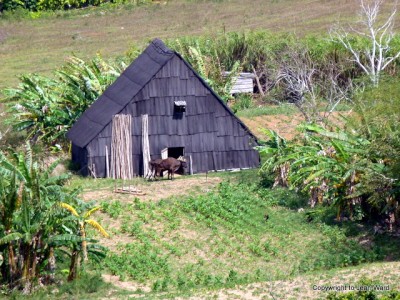
Day one, the four of us shared a taxi tour of the outlying area. There is normally a tourist bus that does the rounds of all the places to see, but for some reason it wasn't operating. The taxis had taken up the slack and were doing the same circuit. We visited caves where runaway slaves had hidden, at Indian River cave we walked in and boated out, just a short distance but very pretty. We drove up to a hilltop hotel and had a magnificent view of the valley then drove up the opposite end for another view of the Mogotes rising from the valley floor. My Insight Guide to Cuba tells me that the mogotes are hard limestone hills which were left when the softer rock eroded eroded over millions of years. After taking a look at Fidels Mural de la Prehistorica which he had painted in 1960 on the rock face of a mogote. The mural is meant to show the emergence of Socialist man from the primal wilderness. Not sure that I saw that but it made a good backdrop for a photo of an ox in the field. Early in the tour we teamed up with another taxi tour, that driver could speak English ours couldn't so it was a good idea.
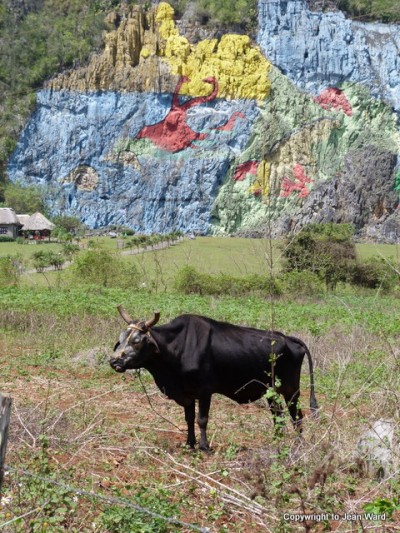
Shortly after leaving Fidels inspiration we turned up a farm road and stopped outside a farmhouse and tobacco drying shed. A little diversion from the bus route. We didn't mind after all part of the reason for going there was to see where the great Cuban cigar comes from. We don't smoke but Cuba without cigars is like New Zealand without hokey pokey icecream. Our English speaking taxi driver gave us a tour of the drying shed which was full of racks of drying leaves. We then went around to the back of the house to have coffee and a cigar rolling demonstration with of course the punch line which was buying cigars. The tobacco farmers have to sell 90% of their crop to the government at a set price which is to put it bluntly...is stuff all. The other 10% they can smoke or sell. The tobacco the farmers keep they dry then preserve in what I would call a marinade, which included lots of natural juices...I cant remember them all but there was rum,pineapple juice and guava amongst others. The tobacco is put in this marinade between two palm leaves and left for at least 50 days. The leaf is then pliable and ready to roll. The selling point for the farm bought cigars is that the process is all natural/organic where as the factories use chemicals to speed up the process. Now don't quote me on all this, I didn't write it down and we have done a few more things since then...a bit of memory fade! The farmer gave us a puff on a cigar...not that we know anything about cigars except you don't inhale. After buying a few cigars the tour was over and we returned to town for a 10 peso pizza for lunch.
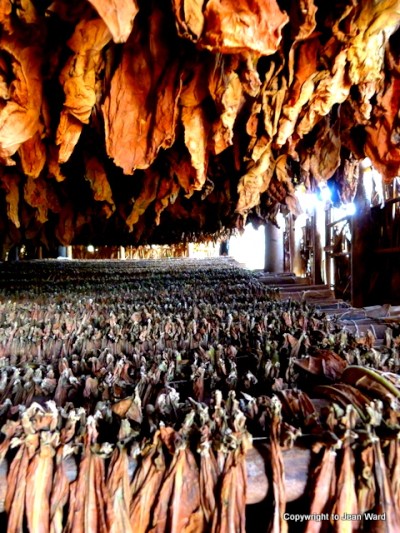
We thought we would rock the afternoon away on the front porch of Maria Luisa before meeting Tony and Angela for sundowners. The front porch of every house in Vinales seems to have at least 2 rocking chairs ready and waiting. A place to watch the world go by..that is if you can find an empty one.
For sundowners we chose a bar that had live music from late afternoon to late night. That day the afternoon band, was led by an 84 year old patriarch/singer, the remaining band members were either his sons or grandchildren, a talented bunch. Between sets he chewed on fat cigar and came to talk to us. His children and many grandchildren are all talented musicians or singers. His grandson in Switzerland has started up a web site and posted videos of the band on UTube. Cuba may be an internet wilderness but with overseas contacts the music gets out. We enjoyed the music until it was time to return to the Casa for our evening meal of fresh fish.
Day two we had arranged for a guided walk into the valley. Our guide, Adrian picked us up at the Casa and we shared the walk with a couple from Austria. The Tana Vikas had a different guide from their Casa and went up a different valley than we did so we compared notes when we got back and found that each walk was the same but different. Adrian could speak excellent English and as we wandered up the uneven dirt track he stopped and explained the use of different plants, told us about the history, the farmers, the cock fights and tobacco farming. Cock fighting is illegal but still happening, a group of men passed us one carrying a cock under his arm. They disappeared into the hills. We noticed the bird had had the feathers shaved off both legs, apparently to keep it cool while fighting. The poor bird was shivering, such a cruel sport.
We passed oxen ploughing the fields, no tractors here. One farmer was using his team of two to pull a simple wooden contraption that cleared the sticks out of the ploughed earth. There was a trail of birds following behind to pick out the insects, an easy lunch.

Farmers were picking the tobacco, hanging the leaves on frames ready to take into the sheds.
Adrian filled in some gaps in our knowledge of tobacco leaf preparation when we visited a drying shed. Then onto another tobacco farmer more rolling demonstrations, but I must say not as good as the day before and the cigars were more expensive. We left a tip for his time and Adrian guided us back to Vinales again. I really enjoyed being out in the country side a nice change from towns no matter how pretty they are.
We had arranged to meet the others after lunch and we wandered town, visited a 100 year old garden and decided to take up our 84 year old musician's invitation to meet his wife of 53 years. We eventually found No 57 and were enthusiastically invited in for coffee, a tour of the garden and more importantly we met his wife. A lovely last afternoon in Cuba.
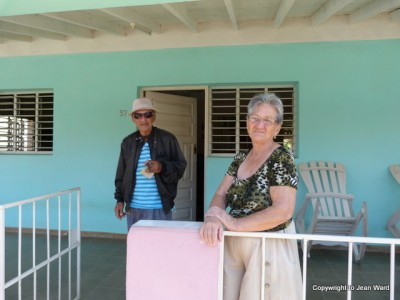
The next day we flew out of Havana, we had spent our last CUCs, passed on the Saliander, Cuba Lonely Planet to Tana Vika and were ready for the next stage of our trip...Mexico.
We have wonderful memories of our Cuba trip and both of us wholeheartedly recommend you go to Cuba and gather some memories of your own.
28 March 2013
Trinidad on the south coast is the third oldest city in Cuba. Now a World Heritage site but in pre Castro times this lovely Colonial town was already recognised as a National Monument. Havana and Trinidad are the two must sees for tourists, after those there are many other interesting places to visit in Cuba. We only had 10 days so decided on just 4 places and spent a few days in each. Cuba is a big island and travelling between places can take time. We had three nights in Trinidad we took our time wandering the cobble stone streets, admiring the pastel coloured houses and enjoying music in the cool of the evening. The south coast was a lot hotter than Havana, we were glad of the little courtyard off our room for afternoon siestas.

The elegant Colonial buildings around the Plaza Major are mainly museums and art galleries but in the 18th Century they were the homes of Sugar plantation owners. The surrounding country side was the main producer of sugar in Cuba although now tourism produces more income in the area with the sugar industry in decline. The pretty plaza is overlooked by the huge Cathedral, Iglesia Paroquial de la Santisima Trinidad with its plain but impressive interior. We went into the Architectural museum, a large restored house dating from 1735. The lady guiding us only had Spanish and we said,"no we don't need a guide, we only have a little espanol ". But she insisted and chatted a way in Spanish while we read the English labels. When we got around the corner out of sight of the main desk she produced a bag of embroidered cloths. We got the message, did we want to buy. Well as it happened I had already looked at some in the street. The beautiful cloths seemed a speciality of the area, I succumbed to one of hers it was lovely and better price than in the shops outside. Deal done, she indicated I should put it in my bag, out of sight, she stashed her bag and we continued on as if nothing happened!! One way for her to earn a little more money to go with the tips she gets from her guiding.
In the streets on the edge of the Plaza is a market for local people to sell their craft, jewellery, paintings, embroidery and some other ingenious items made from recycled cans. Cans turned into cameras that pop out a face, the tabs from cans combined with crochet to make little clutch bags and much more. While discussing these things 3 other NZers heard Alans, "bloody brilliant" and accused us of being Aussies!!! We soon corrected them about that, we couldn't be too rude as its always great to meet our fellow countryfolk and there doesn't seem to be many NZers in this part of the world. We had a nice chat over lunch, saying we may see them again in Trinidad, which we didn't but we did see them days and many miles later in Guatemala.
Being on the coast, Trinidad has some nice beaches so we decided to take the tourist circuit bus out to Playa Ancon and also visit the small marina. We knew that Patrick and Amanda had moved on to Cienfuegos but we would take a look anyway. The marina is only very small and the channel in is quite shallow so not many boats can get in. We found we did know someone there...well sort of, the yacht Tana Vika, we had never met but they come up on the Magellan Net from time to time.
"Come aboard for a cup of tea".
We spent our time between buses chatting, we never did get to the beach. Tony and Angela were off to Vinales by bus the next morning. That morning we had just booked a ticket to Vinales on the same bus. So we ended up spending the next few days in Vinales with them. It was nice to have some travelling companions for a while, Tony and Alan could talk boats for hours while Angela and I enjoyed the scenery.
Vinales is the tobacco growing area of Cuba in the Pinar del Rio province west of Havana. Valle de Vinales is full of green tobacco fields surrounding limestone hills called mogotes. The bus ride from Trinidad was a long one, through brown countryside and sugarcane fields. This is the dry season, the country side is very dry, that is until we climbed the last hill and looked down into the pretty green valley. Tobacco and maize fields dotted with small farm houses and thatched tobacco drying sheds. The bus driver had not said a word for about 9 hours but the proud way he said.
"Valle de Vinales"
as we crested the hill I could tell this was his home.
The town of Vinales is quite small every other house seems to be a Casa Particular and as the bus pulled up there was a bit of a scrum of Casa owners vying for customers. Carlos in Trinidad had booked us into Maria Luisa, "famillia", so we quickly spotted our host holding up our name and away we went, leaving the melee behind. We got down the road and realised Angela and Tony had been dragged off in the opposite direction by their marina "famillia "connection and no arrangements had been made for sundowners. After settling in we walked up the mainstreet , Vinales town is small there is really no where else to go but up the mainstreet! We soon spotted Tony and Angela arranging transport to Havana to meet their daughter 3 days later. Alan and I looked at each other.
What time are you going to Havana on Saturday?"
"in the morning."
We soon had a taxi sharing arrangement going , they would drop us at the airport and carry on into Havana . Going down to the marina had been a good idea. With all that organised we went off to decide what to do for the next 2 days over a cerveza or two. Peter and Raewyn on Saliander gave us their Cuba Lonely Planet back in the San Blas islands and also told us about Vinales so thanks to them we thoroughly enjoyed our time in the green Valle de Vinales.

Day one, the four of us shared a taxi tour of the outlying area. There is normally a tourist bus that does the rounds of all the places to see, but for some reason it wasn't operating. The taxis had taken up the slack and were doing the same circuit. We visited caves where runaway slaves had hidden, at Indian River cave we walked in and boated out, just a short distance but very pretty. We drove up to a hilltop hotel and had a magnificent view of the valley then drove up the opposite end for another view of the Mogotes rising from the valley floor. My Insight Guide to Cuba tells me that the mogotes are hard limestone hills which were left when the softer rock eroded eroded over millions of years. After taking a look at Fidels Mural de la Prehistorica which he had painted in 1960 on the rock face of a mogote. The mural is meant to show the emergence of Socialist man from the primal wilderness. Not sure that I saw that but it made a good backdrop for a photo of an ox in the field. Early in the tour we teamed up with another taxi tour, that driver could speak English ours couldn't so it was a good idea.

Shortly after leaving Fidels inspiration we turned up a farm road and stopped outside a farmhouse and tobacco drying shed. A little diversion from the bus route. We didn't mind after all part of the reason for going there was to see where the great Cuban cigar comes from. We don't smoke but Cuba without cigars is like New Zealand without hokey pokey icecream. Our English speaking taxi driver gave us a tour of the drying shed which was full of racks of drying leaves. We then went around to the back of the house to have coffee and a cigar rolling demonstration with of course the punch line which was buying cigars. The tobacco farmers have to sell 90% of their crop to the government at a set price which is to put it bluntly...is stuff all. The other 10% they can smoke or sell. The tobacco the farmers keep they dry then preserve in what I would call a marinade, which included lots of natural juices...I cant remember them all but there was rum,pineapple juice and guava amongst others. The tobacco is put in this marinade between two palm leaves and left for at least 50 days. The leaf is then pliable and ready to roll. The selling point for the farm bought cigars is that the process is all natural/organic where as the factories use chemicals to speed up the process. Now don't quote me on all this, I didn't write it down and we have done a few more things since then...a bit of memory fade! The farmer gave us a puff on a cigar...not that we know anything about cigars except you don't inhale. After buying a few cigars the tour was over and we returned to town for a 10 peso pizza for lunch.

We thought we would rock the afternoon away on the front porch of Maria Luisa before meeting Tony and Angela for sundowners. The front porch of every house in Vinales seems to have at least 2 rocking chairs ready and waiting. A place to watch the world go by..that is if you can find an empty one.
For sundowners we chose a bar that had live music from late afternoon to late night. That day the afternoon band, was led by an 84 year old patriarch/singer, the remaining band members were either his sons or grandchildren, a talented bunch. Between sets he chewed on fat cigar and came to talk to us. His children and many grandchildren are all talented musicians or singers. His grandson in Switzerland has started up a web site and posted videos of the band on UTube. Cuba may be an internet wilderness but with overseas contacts the music gets out. We enjoyed the music until it was time to return to the Casa for our evening meal of fresh fish.
Day two we had arranged for a guided walk into the valley. Our guide, Adrian picked us up at the Casa and we shared the walk with a couple from Austria. The Tana Vikas had a different guide from their Casa and went up a different valley than we did so we compared notes when we got back and found that each walk was the same but different. Adrian could speak excellent English and as we wandered up the uneven dirt track he stopped and explained the use of different plants, told us about the history, the farmers, the cock fights and tobacco farming. Cock fighting is illegal but still happening, a group of men passed us one carrying a cock under his arm. They disappeared into the hills. We noticed the bird had had the feathers shaved off both legs, apparently to keep it cool while fighting. The poor bird was shivering, such a cruel sport.
We passed oxen ploughing the fields, no tractors here. One farmer was using his team of two to pull a simple wooden contraption that cleared the sticks out of the ploughed earth. There was a trail of birds following behind to pick out the insects, an easy lunch.

Farmers were picking the tobacco, hanging the leaves on frames ready to take into the sheds.
Adrian filled in some gaps in our knowledge of tobacco leaf preparation when we visited a drying shed. Then onto another tobacco farmer more rolling demonstrations, but I must say not as good as the day before and the cigars were more expensive. We left a tip for his time and Adrian guided us back to Vinales again. I really enjoyed being out in the country side a nice change from towns no matter how pretty they are.
We had arranged to meet the others after lunch and we wandered town, visited a 100 year old garden and decided to take up our 84 year old musician's invitation to meet his wife of 53 years. We eventually found No 57 and were enthusiastically invited in for coffee, a tour of the garden and more importantly we met his wife. A lovely last afternoon in Cuba.

The next day we flew out of Havana, we had spent our last CUCs, passed on the Saliander, Cuba Lonely Planet to Tana Vika and were ready for the next stage of our trip...Mexico.
We have wonderful memories of our Cuba trip and both of us wholeheartedly recommend you go to Cuba and gather some memories of your own.
Comments
| Vessel Name: | Tuatara |
| Vessel Make/Model: | Alan Wright 51 |
| Hailing Port: | Opua NZ |
| Crew: | Alan and Jean Ward |
Gallery not available
Sailing in the Pacific
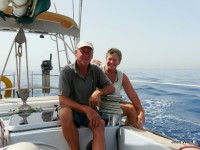
Who: Alan and Jean Ward
Port: Opua NZ

